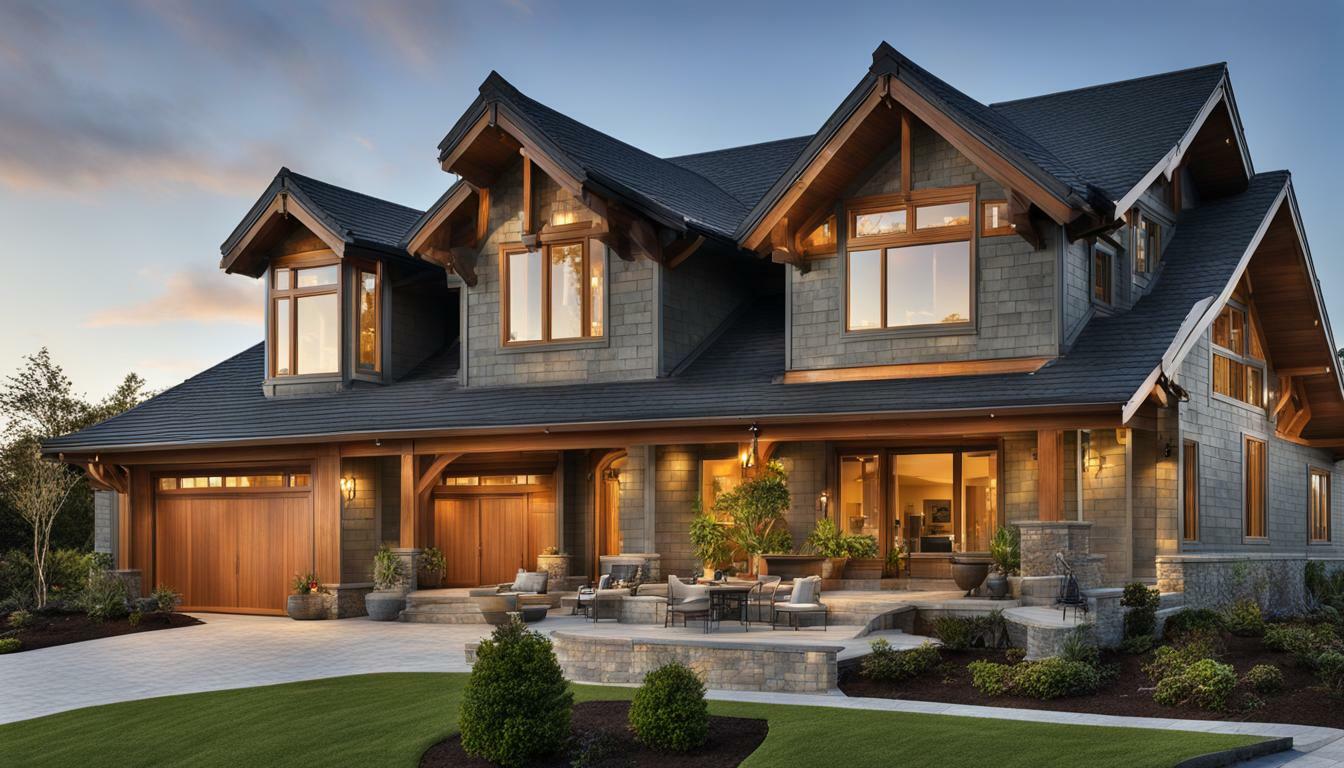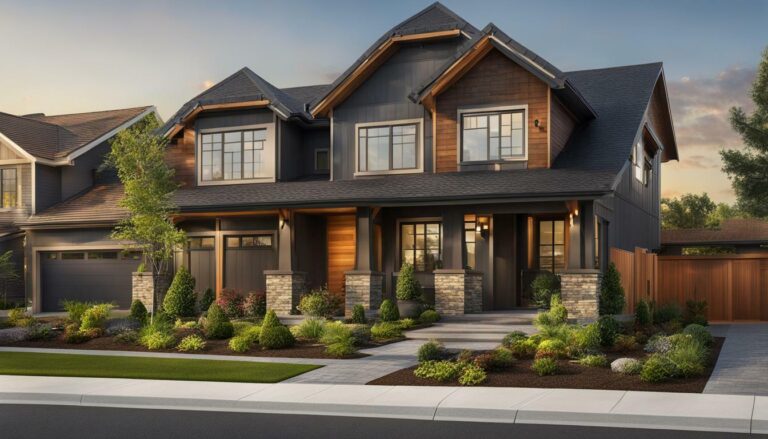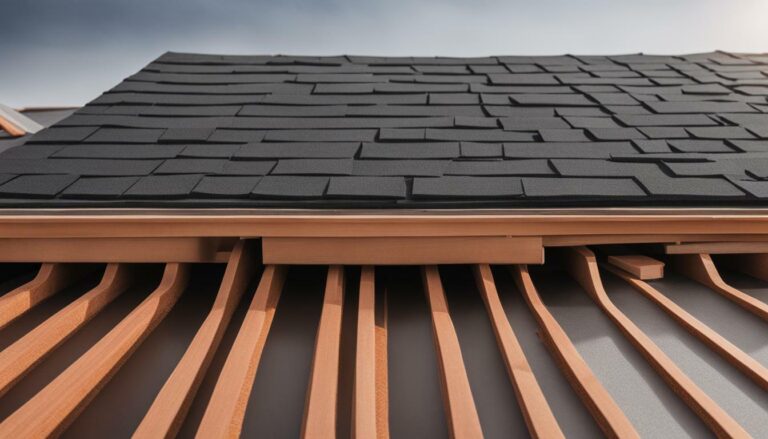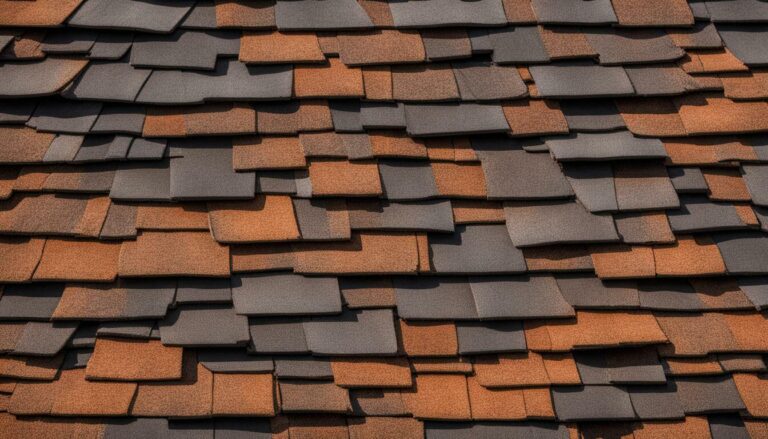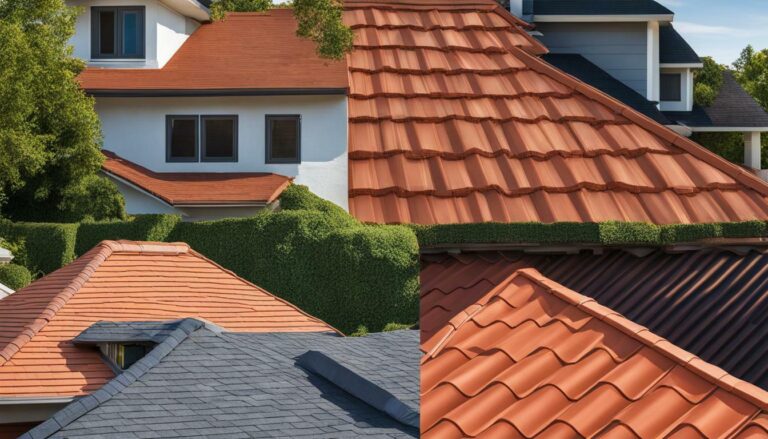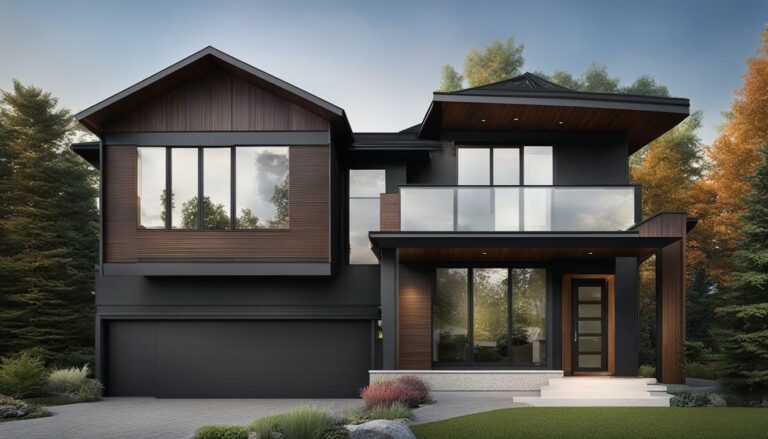Expert Guide: Choosing Roofing for Coastal Homes in the U.S.
When it comes to roofing for coastal homes in the U.S., selecting the right materials is crucial to ensure durability and protection against the elements. Choosing materials that can withstand the harsh conditions of coastal areas is essential for the longevity and function of the roof. Additionally, considering the aesthetic value of the roofing material can greatly enhance the overall look of your coastal home.
Key Takeaways:
– Clay tile roofs are a popular choice for coastal homes, particularly in Mediterranean-inspired coastal areas like Florida and Southern California. They offer durability and resistance to water and sea air.
– Metal roofs, such as steel, stainless steel, and galvanized steel, are known for their strength, resistance to corrosion, and energy efficiency. They can reflect heat, keeping your home cooler, and have a lifespan of up to 50 years.
– Copper roofs are luxurious and unique, commonly used in beach mansions. They are resistant to corrosion and require minimal maintenance. However, they are expensive and vulnerable to scratching and denting.
– Wood shingles and shakes, especially Western red cedar, are classic choices for coastal homes, particularly in regions like New England. With proper treatment and maintenance, wood roofs can last for decades.
– Thatch roofs, made from dried reeds and grasses, are commonly found in tropical coastal locations. They provide insulation and a distinct tropical aesthetic.
When selecting roofing materials for coastal homes, it’s important to consider factors such as weather resistance, insulation, maintenance requirements, aesthetic appeal, and cost. Coastal roofs should be able to withstand corrosion, strong winds, and impact. Insulation is crucial for extreme temperatures, and low-maintenance options may be preferred. The roofing material should also complement the style of the home and fit within your budget.
Popular coastal roofing materials include copper, slate, clay tiles, metal roofs (such as galvanized steel and aluminum), and wood shingles. Consulting with a roofing professional is highly recommended to ensure the proper selection and installation of the chosen material for your coastal home.
Remember, choosing the right roofing material is key to protecting your coastal home and enhancing its overall aesthetic appeal. Plan accordingly and consult with professionals to make an informed decision.
Before diving into specific roofing materials, it’s essential to understand the factors you should consider when selecting roofing for coastal homes. The coastal environment presents unique challenges that require careful planning and consideration.
1. Weather Resistance: Coastal areas are prone to high winds, heavy rain, and saltwater exposure. It’s crucial to choose roofing materials that can withstand these harsh conditions without deteriorating or sustaining damage. Look for materials specifically designed for hurricane resistance and durability.
| Roofing Material | Hurricane Resistance | Waterproofing |
|---|---|---|
| Clay Tile | Good | Good |
| Metal Roof | Excellent | Excellent |
| Copper Roof | Moderate | Good |
| Wood Shingles/Shakes | Good | Moderate |
| Thatch Roof | Poor | Poor |
2. Insulation: Coastal areas often experience extreme temperatures. Select roofing materials that provide good insulation to help maintain a comfortable indoor environment and reduce energy costs. Insulated metal roofs and wood roofs with proper underlayment can offer excellent thermal performance.
3. Maintenance Requirements: Consider the maintenance needs associated with each roofing material. Some materials, such as metal roofs, require minimal maintenance, while others, like wood shakes, may need regular treatments or repairs. Choose materials that fit your lifestyle and maintenance capabilities.
4. Aesthetic Appeal: Coastal homes often have a unique architectural style and visual appeal. Opt for roofing materials that enhance the overall aesthetic of your home and complement its surroundings. Clay tiles, copper roofs, and wood shingles/shakes can add charm and character to coastal residences.
By carefully evaluating these factors, you can make an informed decision when selecting roofing materials for your coastal home. Next, let’s explore specific roofing options that are well-suited for beachfront properties.

Now that you’ve considered the factors to keep in mind when choosing roofing for coastal homes, let’s delve into the specific materials that are popular and suitable for beachfront properties. From clay tiles to metal roofs, copper roofs to wood shingles, and even thatch roofs for a tropical aesthetic, there are various options to meet your needs and preferences. Choose a roofing material that offers the perfect combination of durability, protection, and aesthetics for your coastal home.
Clay Tile Roofs for Coastal Homes
Clay tile roofs are a popular choice for coastal homes in areas that draw inspiration from the Mediterranean aesthetic, such as Florida and Southern California. These roofs not only provide a beautiful and distinctively charming look but also offer several practical benefits.
One of the key advantages of clay tile roofs is their durability. They are highly resistant to water and sea air, making them ideal for coastal locations where the saltwater and high humidity can cause damage to other roofing materials. Clay tiles can withstand harsh weather conditions, including strong winds and heavy rain, offering long-term protection for coastal homes.
Another benefit of clay tile roofs is their natural insulation properties. The dense composition of clay helps to regulate the temperature inside the home, keeping it cooler in hot climates and reducing the need for excessive air conditioning. This can result in energy savings, making clay tile roofs not only aesthetically pleasing but also environmentally friendly.
| Advantages of Clay Tile Roofs for Coastal Homes: |
|---|
| Durable and resistant to water and sea air |
| Strong protection against harsh weather conditions |
| Natural insulation properties, reducing energy consumption |
“Clay tile roofs provide a timeless and elegant appearance to coastal homes, capturing the essence of Mediterranean-inspired architecture. The rustic charm combined with the practical benefits of durability and insulation make clay tile roofs a top choice for homeowners seeking both style and functionality.”
Image:
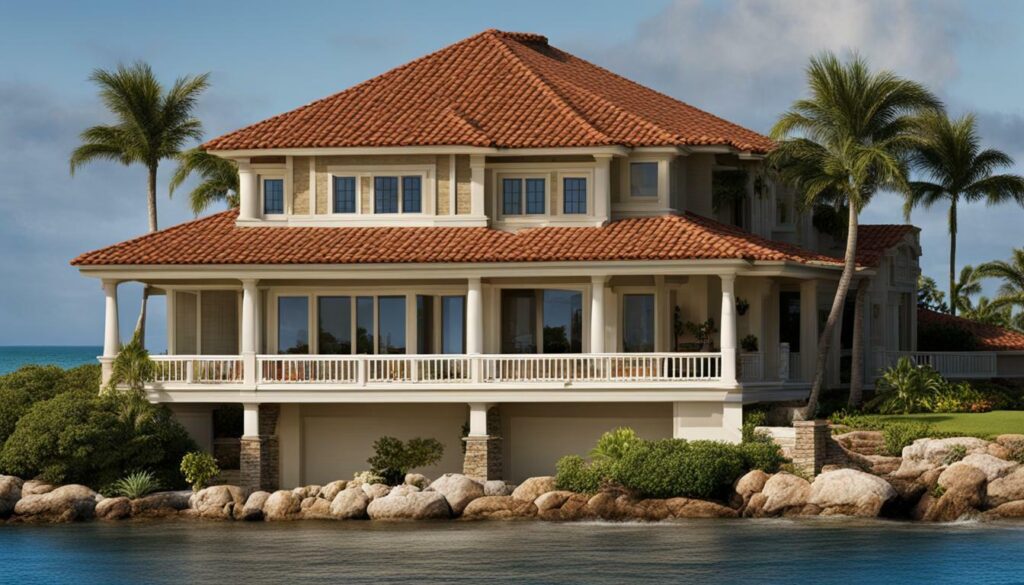
With proper installation and maintenance, clay tile roofs can last for decades, ensuring long-term protection and value for coastal homeowners. However, it’s important to consult with a roofing professional to ensure the correct installation techniques and to choose clay tiles suitable for coastal environments.
The timeless beauty, durability, and practical benefits of clay tile roofs make them an excellent choice for coastal homes in Mediterranean-inspired areas like Florida and Southern California.
Metal Roofs for Coastal Homes
Metal roofs, such as those made of steel, stainless steel, or galvanized steel, offer a range of benefits for coastal homes, including exceptional strength and corrosion resistance. These materials are designed to withstand the harsh coastal elements, including saltwater spray, high winds, and intense sunlight.
One of the key advantages of metal roofs is their durability. They can last up to 50 years or more with proper maintenance, making them a long-term investment for coastal homeowners. Metal roofs are also highly resistant to corrosion, which is essential in areas with high salt content in the air. This resistance helps to prevent rust and deterioration, ensuring the roof retains its integrity over time.
Additionally, metal roofs are energy-efficient. They reflect heat from the sun, reducing the cooling load on the home and potentially lowering energy bills. This can be particularly beneficial in hot coastal regions where the sun’s rays are intense.
When considering a metal roof for your coastal home, it is important to choose the right type of metal and ensure proper installation. Consult with a roofing professional to determine which metal material is best suited for your specific coastal location and to ensure a proper fit and installation. With the right choice and installation, a metal roof can provide both practical and aesthetic value to your coastal home.
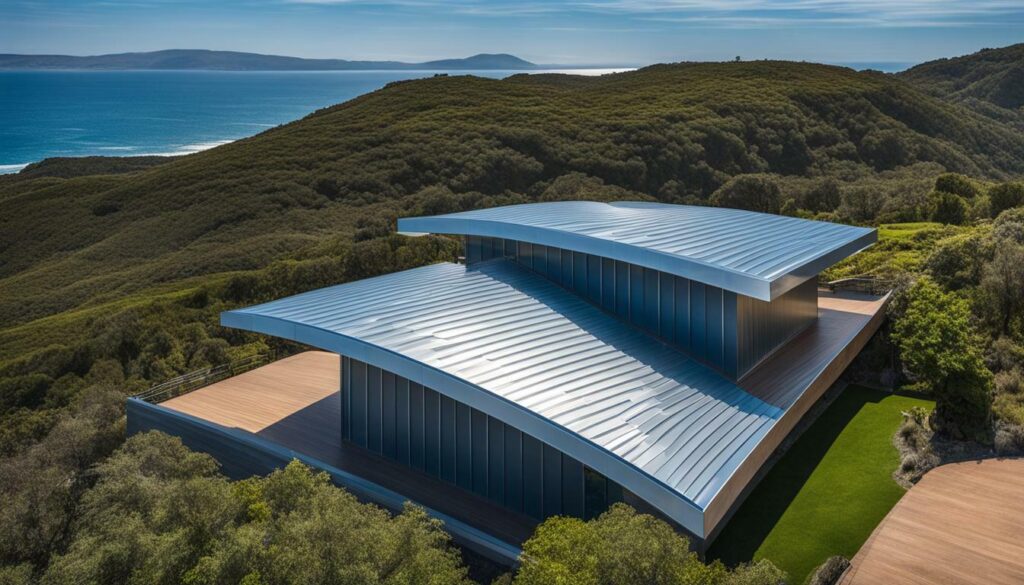
| Metal Roofing Materials | Strength | Resistance to Corrosion | Energy Efficiency |
|---|---|---|---|
| Steel | High | Excellent | Good |
| Stainless Steel | High | Excellent | Good |
| Galvanized Steel | High | Excellent | Good |
Copper Roofs for Coastal Homes
For those seeking an exquisite and distinctive roofing option, copper roofs provide exceptional corrosion resistance and a touch of luxury, albeit at a higher cost. Copper is known for its durability and ability to withstand the harsh coastal elements, making it an ideal choice for homes near the ocean.
Copper roofs not only offer excellent protection against corrosion but also develop a beautiful patina over time, adding character and charm to the home’s exterior. With proper maintenance, a copper roof can last for centuries, making it a long-term investment that adds value to coastal properties.
Although copper roofs require minimal maintenance, occasional inspections and repairs may be necessary to ensure their longevity. It’s important to hire a professional roofing contractor experienced in working with copper to handle any maintenance or repair needs. Regular inspections can help identify any potential issues, such as loose or damaged tiles, and address them promptly to prevent further damage.
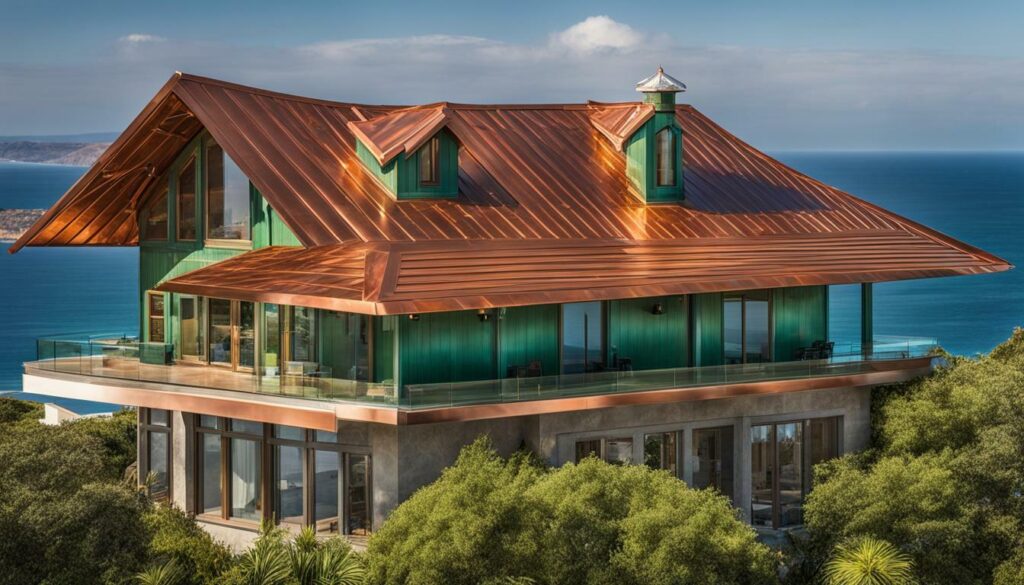
| Pros | Cons |
|---|---|
| Exceptional corrosion resistance | Higher upfront cost |
| Luxurious and unique aesthetic | Susceptible to scratching and denting |
| Durable and long-lasting | Requires occasional maintenance |
When considering a copper roof for your coastal home, it’s essential to factor in the higher initial investment. While copper roofs may come with a higher price tag compared to other roofing materials, their longevity and beauty make them worthwhile for homeowners looking for a distinctive look and long-term durability.
In summary, copper roofs offer exceptional corrosion resistance, a touch of luxury, and durability for coastal homes. They require minimal maintenance and develop a beautiful patina over time. Although they come at a higher cost, their unique aesthetic and long-lasting nature make them a popular choice for those seeking a high-end roofing option.
Wood Shingles and Shakes for Coastal Homes
Wood shingles and shakes, especially those made from Western red cedar, have long been a popular choice for coastal homes in New England due to their durability and timeless charm. These traditional roofing materials not only enhance the aesthetic appeal of beachfront properties but also offer practical benefits.
One of the key advantages of wood shingles and shakes is their durability. When properly treated and maintained, they can last for decades, with some roofs even surpassing 40 years in service. Western red cedar, in particular, is known for its natural resistance to rot, decay, and insect damage, making it well-suited for the coastal environment where moisture and salt exposure are common.
Furthermore, wood roofs offer excellent insulation properties, helping to regulate temperature and reduce energy consumption. They provide natural ventilation, allowing air to circulate beneath the shingles and shakes, which can help keep the interior of the home cooler during hot summer months. This can be especially beneficial in coastal regions where temperatures can soar.
To maintain the longevity and appearance of wood roofs, regular maintenance is necessary. This includes periodic cleaning to remove debris, moss, or algae, as well as treating the wood with protective coatings to prevent weathering. It’s also important to inspect the roof regularly for any signs of damage, such as cracked or missing shingles, and address them promptly to prevent further issues.
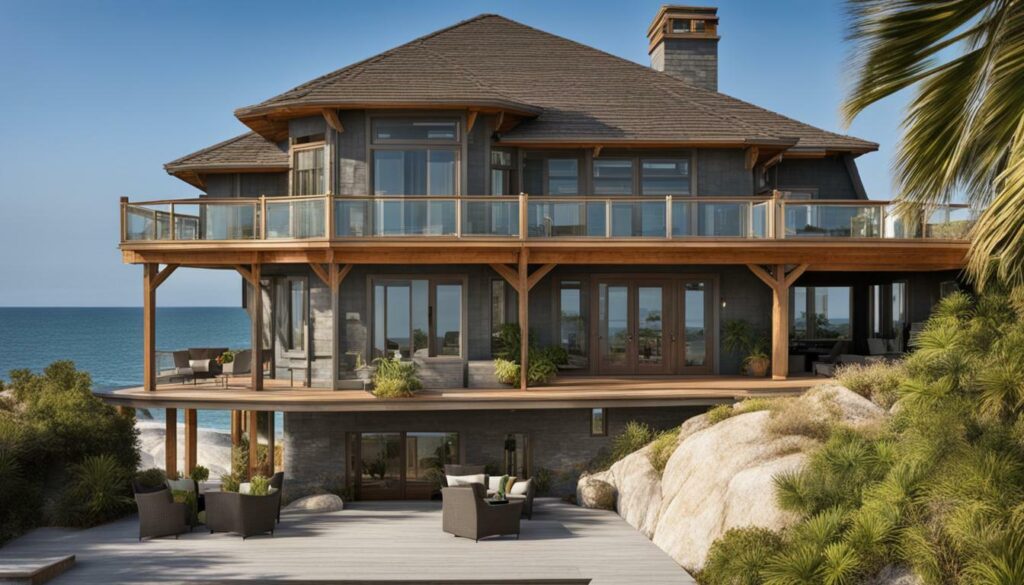
| Durability | Insulation | Timeless Charm |
|---|---|---|
| Can last up to 40 years or more with proper maintenance | Provide natural ventilation and help regulate temperature | Add a classic and timeless aesthetic to beachfront properties |
| Resistant to rot, decay, and insect damage | Reduce energy consumption and keep interior cooler | Complement the natural beauty of coastal surroundings |
When considering wood shingles and shakes for your coastal home, it’s important to consult with a roofing professional who specializes in these materials. They can guide you in choosing the right type of wood, provide maintenance recommendations, and ensure proper installation for optimal performance and longevity.
Thatch Roofs for Coastal Homes
Thatch roofs, crafted from dried reeds and grasses, are a popular roofing material in tropical coastal locations, offering both insulation and a unique aesthetic. With their natural ability to provide excellent insulation, thatch roofs help keep homes cool in the hot climates of coastal areas. The thick layers of thatch act as a barrier against heat, reducing the need for excessive air conditioning and lowering energy costs.
Not only do thatch roofs provide practical benefits, but they also add a touch of tropical charm to coastal homes. The rustic and organic appearance of thatch complements the natural surroundings, creating a harmonious blend between the house and its coastal environment. Whether you’re living in a beachfront cottage or a luxury tropical villa, a thatch roof can enhance the overall look and feel of your coastal home.
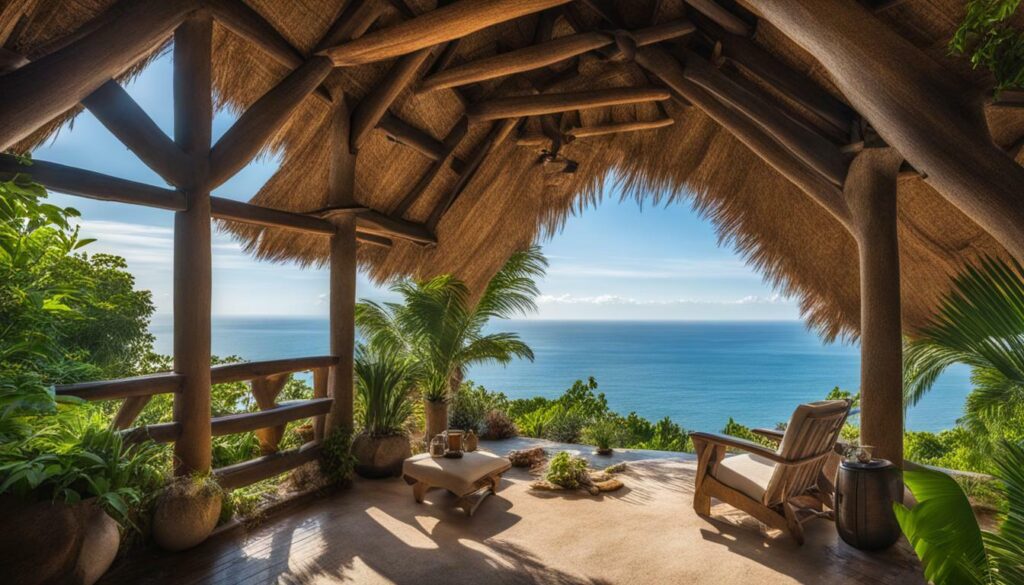
For those concerned about the longevity of thatch roofs, rest assured that with proper maintenance and care, they can endure for many years. Natural thatch roofs can last up to 20 years, while synthetic thatch can have a lifespan of over 50 years. Routine maintenance, such as replacing damaged or worn thatch, can help extend the life of the roof. Additionally, regular application of fire retardant treatments can enhance the fire resistance of thatch roofs, providing an added layer of protection for your coastal home.
In conclusion, thatch roofs are an excellent choice for tropical coastal homes, offering insulation, aesthetic appeal, and a unique charm. Their ability to provide natural cooling and withstand the demands of coastal climates makes them a practical and sustainable option. Consider consulting with a roofing professional to determine if a thatch roof is the right choice for your coastal home.
Considerations for Coastal Roofing
When selecting roofing materials for coastal homes, it’s essential to consider various factors, including weather resistance, insulation properties, maintenance requirements, aesthetic appeal, and cost. Coastal areas are prone to harsh weather conditions, such as strong winds, heavy rainfall, and saltwater exposure, which can significantly impact the longevity and performance of a roof. Therefore, it is crucial to choose materials that can withstand these challenges and provide optimal protection for coastal homes.
Evaluating the weather resistance of different roofing options is paramount. Coastal roofs should be able to withstand high winds, resist water infiltration, and remain durable in the face of constant exposure to saltwater and UV rays. Materials like clay tiles, metal roofs, and certain types of wood shingles have proven to be excellent choices for coastal areas due to their ability to withstand these elements.
Insulation is another crucial consideration for coastal roofs, as extreme temperatures and humidity levels are common in beachfront locations. Proper insulation can help regulate the indoor temperature, ensuring comfort and energy efficiency. Additionally, it can prevent the formation of condensation and reduce the risk of mold and mildew growth.
Maintenance requirements should also be taken into account when choosing roofing materials for coastal homes. Low-maintenance options are often preferred in these areas, as the corrosive effects of saltwater and the potential for damage from hurricanes or tropical storms can make regular maintenance challenging. However, regular inspections and upkeep are still necessary to extend the lifespan of the roof and address any minor issues before they escalate.
Cost is another significant factor to consider
Coastal roofing projects can vary greatly in cost depending on the selected materials, the size of the property, and the complexity of the installation. While it may be tempting to opt for more budget-friendly options, it is important to strike a balance between cost and quality. Investing in higher-quality materials, such as copper, slate, or durable metal roofs, may result in higher upfront costs but can pay off in terms of longevity and overall performance.
By carefully considering these factors, coastal homeowners can make informed decisions about roofing materials that will not only withstand the challenging coastal environment but also enhance the aesthetic appeal of their homes. Consulting with a roofing professional is highly recommended to ensure the proper selection and installation of the chosen material, taking into account all the unique considerations of coastal roofing projects.
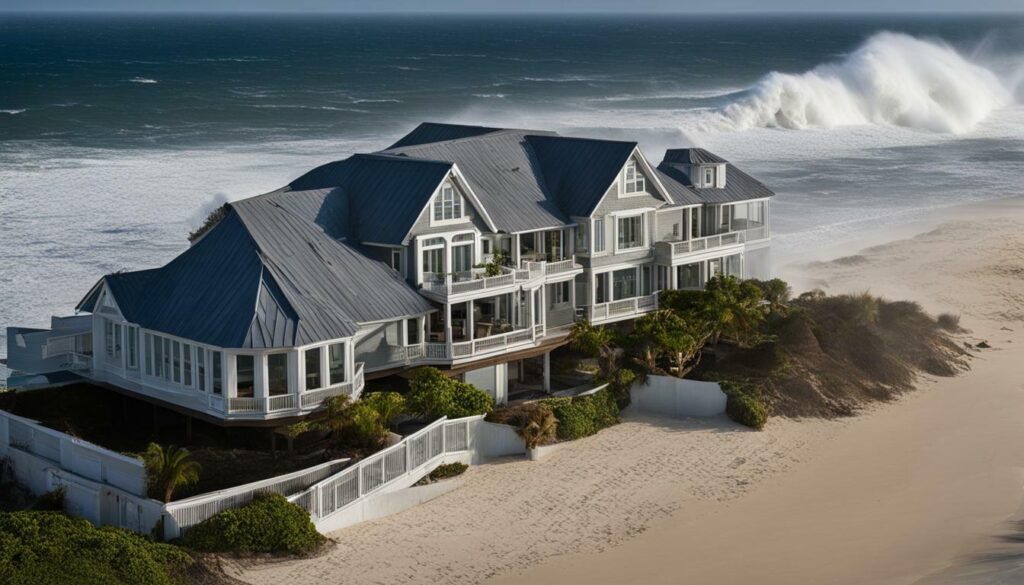
| Factors to Consider | Recommended Materials |
|---|---|
| Weather Resistance | Clay tiles, metal roofs (steel, stainless steel, galvanized steel) |
| Insulation Properties | Clay tiles, metal roofs, wood shingles and shakes |
| Maintenance Requirements | Metal roofs, clay tiles, slate |
| Aesthetic Appeal | Copper, slate, wood shingles and shakes, clay tiles |
| Cost | Metal roofs, clay tiles, wood shingles and shakes |
Popular Coastal Roofing Materials
Several roofing materials are commonly chosen for coastal homes, including copper, slate, clay tiles, metal roofs, and wood shingles. Each material offers unique advantages and considerations for homeowners looking to protect their coastal properties.
Copper
One popular choice for coastal homes is copper roofing. With its natural beauty and timeless appeal, copper roofs add a touch of luxury to any beachfront property. Copper is highly resistant to corrosion, making it ideal for areas with high saltwater exposure. However, copper roofing is expensive and requires regular maintenance to preserve its appearance and prevent oxidation.
Slate
Slate roofs are renowned for their durability and longevity, making them a reliable option for coastal homes. Slate is a natural stone that can withstand harsh weather conditions, including high winds, heavy rains, and intense sun exposure. While slate roofing is more expensive upfront, its exceptional durability can lead to long-term cost savings. Additionally, slate roofs offer a timeless aesthetic that complements the coastal environment.
Clay Tiles
Clay tiles have been used for centuries and are a common roofing material in coastal regions. They are particularly popular in warmer climates like Florida and Southern California, where their natural thermal properties help keep homes cool. Clay tiles are resistant to moisture, fire, and insects, making them an excellent choice for coastal areas prone to hurricanes and other extreme weather events.
Metal Roofs
Metal roofs, such as galvanized steel and aluminum, are gaining popularity for their strength, longevity, and resistance to corrosion. They offer excellent protection against salt air, wind, and rain, making them well-suited for coastal homes. Metal roofs are also energy-efficient as they reflect sunlight, helping to reduce cooling costs in warmer climates. However, metal roofs can be noisy during heavy rainfall and may require occasional maintenance to prevent rusting.

Consider consulting with a roofing professional to assess your specific coastal conditions and determine the most suitable roofing material for your home. They can provide expert guidance and recommend the best options based on your budget, desired aesthetics, and long-term maintenance needs.
| Roofing Material | Advantages | Considerations |
|---|---|---|
| Copper | – Luxurious appeal – Resistance to corrosion |
– Expensive upfront cost – Requires regular maintenance |
| Slate | – Exceptional durability – Longevity – Timeless aesthetic |
– Higher upfront cost – Requires professional installation |
| Clay Tiles | – Thermal properties for cooling – Resistance to moisture, fire, and insects |
– Heavyweight requires structural support – Can be brittle and prone to cracking |
| Metal Roofs | – Strength and longevity – Resistance to corrosion and extreme weather – Energy-efficient |
– Can be noisy during heavy rainfall – May require occasional maintenance |
Consulting with a Roofing Professional
To ensure the optimal selection and installation of roofing materials for your coastal home, it is highly recommended to consult with a qualified roofing professional. Coastal homes face unique challenges due to their proximity to the ocean and exposure to salt air, strong winds, and potential hurricanes. A roofing professional with expertise in coastal construction and maintenance can guide you in choosing the right materials that will withstand these harsh conditions while complementing the aesthetic appeal of your home.
A roofing professional will assess your specific needs and recommend the most suitable options for your coastal property. They will consider factors such as weather resistance, insulation requirements, maintenance needs, and budget constraints. By working with a professional, you can ensure that your roofing project is properly planned and executed, minimizing the risk of costly repairs or replacements down the line.
Additionally, a roofing professional can handle the installation process, ensuring that it is done correctly and efficiently. The proper installation of roofing materials is crucial for their longevity and performance. With the expertise of a professional, you can have peace of mind knowing that your coastal home is protected by a durable and reliable roof that will withstand the test of time.

- Expert knowledge of coastal construction and maintenance
- Assessment of specific needs and recommendations based on your property
- Professional guidance in selecting materials that withstand coastal conditions
- Proper installation to maximize longevity and performance
- Peace of mind knowing your home is protected by a reliable roof
To make informed decisions about roofing materials for your coastal home, consult with a roofing professional. Their expertise will ensure that you choose the right materials, have a proper installation, and enjoy a durable and beautiful roof that enhances the value and resilience of your coastal property.
Conclusion
Selecting the right roofing materials for coastal homes is crucial to ensure long-lasting durability, protection against the harsh coastal environment, and a visually appealing aesthetic. When choosing roofing for your beach home, consider the factors that are unique to coastal areas, such as the corrosive effects of saltwater, high winds, and intense sunlight.
Popular choices for coastal homes include clay tile roofs, which offer durability and resistance to water and sea air. Metal roofs, such as steel, stainless steel, and galvanized steel, provide strength, corrosion resistance, and energy efficiency. If you’re looking for a luxurious option, copper roofs are not only visually stunning but also highly resistant to corrosion. Wood shingles and shakes are classic choices for coastal homes, particularly in regions like New England, known for their durability and timeless aesthetic.
It’s important to consider factors like weather resistance, insulation, maintenance requirements, aesthetic appeal, and cost when selecting roofing materials for your coastal home. Coastal roofs should be able to withstand the corrosive effects of saltwater, strong winds, and potential impacts from debris. Adequate insulation is crucial to maintain a comfortable indoor temperature, while low-maintenance options can help ease the upkeep of your roof. Additionally, choosing a roofing material that complements the architectural style of your home and fits within your budget is also essential.
To ensure the proper selection and installation of your coastal roofing materials, it is highly recommended to consult with a roofing professional. They can provide expert guidance tailored to your specific needs and ensure that your chosen material is installed correctly to maximize its longevity and performance. With the right roofing materials in place, you can enjoy a durable, protected, and beautiful roof for years to come.
FAQ
Q: What factors should I consider when choosing roofing for coastal homes?
A: When choosing roofing for coastal homes, it’s important to consider factors such as weather resistance, insulation, maintenance requirements, aesthetic appeal, and cost. Coastal roofs should be resistant to corrosion, wind, and impact. Insulation is important for extreme temperatures, and low-maintenance options may be preferred. The roofing material should also complement the style of the home and fit within the budget.
Q: What are some popular roofing materials for coastal homes?
A: Popular roofing materials for coastal homes include copper, slate, clay tiles, metal roofs (such as galvanized steel and aluminum), and wood shingles. These materials offer durability, protection against coastal elements, and a range of aesthetic options.
Q: Are clay tiles suitable for coastal homes?
A: Yes, clay tiles are a popular choice for coastal homes, especially in Mediterranean-inspired coastal areas like Florida and Southern California. They are durable and resistant to the effects of water and sea air.
Q: Are metal roofs a good option for coastal homes?
A: Yes, metal roofs are a popular choice for coastal homes. Materials such as steel, stainless steel, and galvanized steel offer strength, resistance to corrosion, and energy efficiency. They can reflect heat, keeping the home cooler, and have a lifespan of up to 50 years.
Q: What are the advantages of copper roofs for coastal homes?
A: Copper roofs are unique and luxurious, often used in beach mansions with an old-world feel. They are resistant to corrosion and can last for centuries with little maintenance. However, they are expensive and susceptible to scratching and denting.
Q: Are wood shingles and shakes suitable for coastal homes?
A: Yes, wood shakes and shingles, particularly Western red cedar, are classic choices for coastal homes, especially in New England. With proper treatment and maintenance, wood roofs can last up to 40 years or more.
Q: What is thatch roofing and is it suitable for coastal homes?
A: Thatch is a distinctive roofing material made from dried reeds and grasses. It is commonly used in tropical locations and provides insulation and a tropical aesthetic. Thatch can last up to 20 years naturally and over 50 years with synthetic thatch.
Q: Should I consult with a roofing professional when choosing roofing for my coastal home?
A: Yes, it is recommended to consult with a roofing professional to ensure the proper selection and installation of the chosen roofing material for your coastal home. They can provide expert advice based on your specific needs and requirements.
